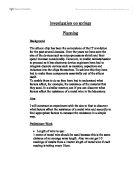Prediction
I think the speed of sound, when using the higher frequency tuning fork; will increase if a low frequency tuning fork is used. When a higher frequency is used, the wavelength is shorter according to the speed equation, where f ∝ v so when f is high frequency the wavelength is shorter. When wavelength is shorter the speed is also lower compared to a high frequency object. The speed of sound is higher in higher temperature. Using the speed of sound equation the higher the temperature the faster the sound.
Observations:
Knowledge and Understanding
- The sound emitted by each tuning fork is:
- The speed of the waves using the universal wave equation, for each tuning fork is:
- The wave speed of the first tuning fork was faster than the wave speed of the second tuning fork. I am surprised because the frequency of the first tuning fork was higher than the frequency of the second tuning fork. According to, the universal wave equation, . This means that when frequency increases wavelength decreases. This is the case in question 1; the tuning fork with the higher frequency had the lower wavelength. However if wavelength decreases speed should also be slower compared to the speed of the low frequency tuning fork. But according to the calculations, the high frequency tuning fork has a higher speed than the low frequency tuning fork.
- The wave speed of both tuning forks with different frequencies is faster in room temperature than in the different temperature. I am not surprised because since room temperature was higher, the wave should be travelling faster. The temperature outside was much lower which explains the low speed of the sound waved in the different temperature.
- The speed of sound based on the temperature of air in each location is:
Thinking and Investigation:
- The % error of the wave speed of each tuning fork is:
The % error for the speed of sound in room temperature seems reasonable because in every lab there is bound to be some kind of error. The percent error is very low which can be a result of the environment (air slowing down the vibrations) or maybe even the accuracy of the 1st resonant length reading. A few percent may also be a difference in rounding the numbers. However the % error for the speed of sound in the different temperature doesn’t seem to be reasonable. The same reasons for the error should apply because the same procedure was performed to obtain the 1st resonance for the different temperature. The error may be because the air may have had a greater impact when performing the experiment outside. There was a lot of wind which may have lowered the temperature than expected. This may have been caused the slower speed of sound. Even though there might have been uncontrollable errors, the 60% and 50% seems too big of an error and it seems odd that the experimental speed is a possible result only if the temperature was below 0







